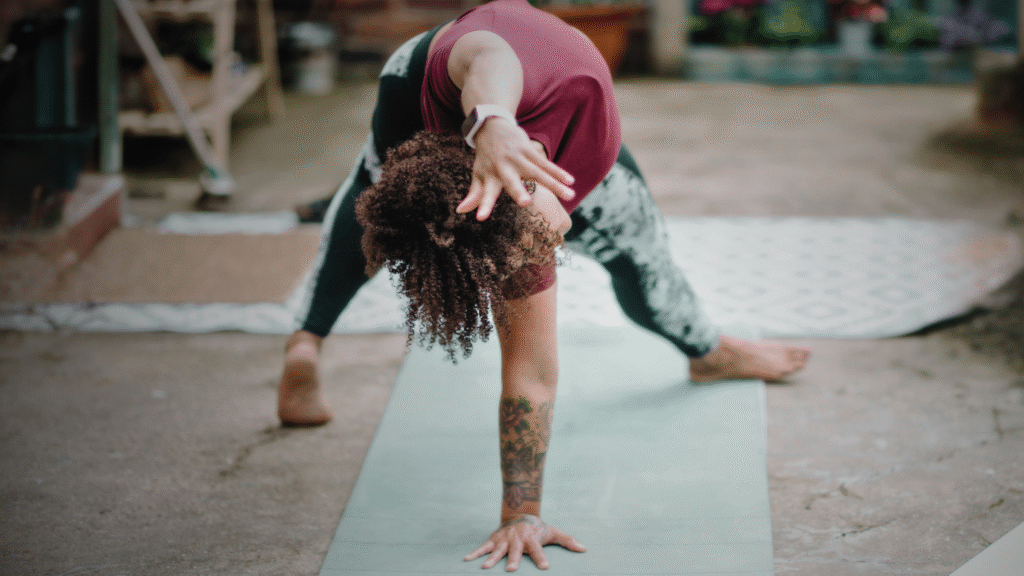Always handle your body with care.
(Photo: Canva)
Published August 12, 2025 04:45AM
Even the most common yoga poses can be undeniably tricky. Whether its an unexpected entry, some funky cueing, or simply an off day, stepping into certain postures can call for a little extra information. A warning, if you will.
So we asked our editors and followers on social which yoga poses they believe should come with a warning sign. The answers ranged from the humorous to the all too real, whether the general confusion of Wild Thing or the twisted-up nature of Eagle. So, consider yourself warned: these yoga poses may require an extra touch of mindfulness.
16 Yoga Poses That Should Come with a Warning Sign
One commenter noted that it might be the practitioners themselves that should pause before posing, taking stock (internally, of course) of mobility, injuries, and flexibility prior to attempting certain shapes. Yes, always.
1. One commenter noted that Four-Limbed Staff Pose, more commonly known as Chaturanga Dandasana, can irk and injure shoulders when done too frequently. They choose to opt out during vinyasas. (Some teachers would note that this response isn’t due to the pose itself, but rather the alignment.)
2. Happy Baby.
3. Headstand (Sirsasana) came up over and over again. Some yoga teachers choose not to include the pose in practices due to its potential for neck compression and a regard for student safety. “I can do it but I won’t teach it,” says one commenter.
4. As a backbend, Camel Pose (Ustrasana) may seem simple, but a thoughtless or hasty entry can result in dizziness and undue neck strain.
5. Lotus Pose (Padmasana) is one of the most recognizable yoga poses. It’s also not for everyone. Those with tight hip flexors, any sort of knee or ankle injury, or hips that simply don’t move in this way would do well to skip.
6. Do a quick check-in with your back and hamstrings before folding deeply in Seated Forward Bend. Sometimes, it’s more than sufficient to stay in Staff Pose.
7. Half Moon (Ardha Chandrasana) is a beautiful balancing act. But without proper cueing, rotating your lower body into this side-facing shape can crank your hips. Remember to properly stabilize before opening out into the pose.
8. A common question we ask when coming into Wild Thing: Where am I? This shape can be disorienting, and stepping your foot over and into the unknown requires an unexpected amount of trust. But as one editor notes, when you push through your straight leg, lift your hips, and release your upper back, the risk is worth the reward.
9. Approach Goddess Pose—and Squat (Malasana), for that matter—with care. Protect your knees by angling them outward over your second toe and listening to your body.
10. Don’t even get us started on Warrior 1.
11. Legs Up the Wall is a seriously restorative pose, but it does require embracing the support of the posture, lest your legs slide down the wall in less-than-relaxing fashion. Try taking your legs hip-distance apart, so the femurs can sink into the hip sockets, and seriously let your legs rest against the wall. You might need to scooch your hips a touch farther away from it to experience that.
12. Skandasana or Side-Lunge. One commenter was certain their knee might pop out of place when they recently attempted this pose.
13. The twists and binds that make up Eagle Pose are not for every body. One commenter notes that they could use a warning sign that reminds them not to get frustrated by this reality.
14. The potential for knee damage is real in Pigeon Pose, especially if your hips don’t have sufficient range of motion. If you find yourself not making the shape (or wanting to scream), take a Figure-4 stretch on your back instead.
15. Hero Pose demands a lot of your knees. Go slowly and stop when your body tells you it’s had enough.
16. Beware of Child’s Pose! Once there, you may never want to leave.


